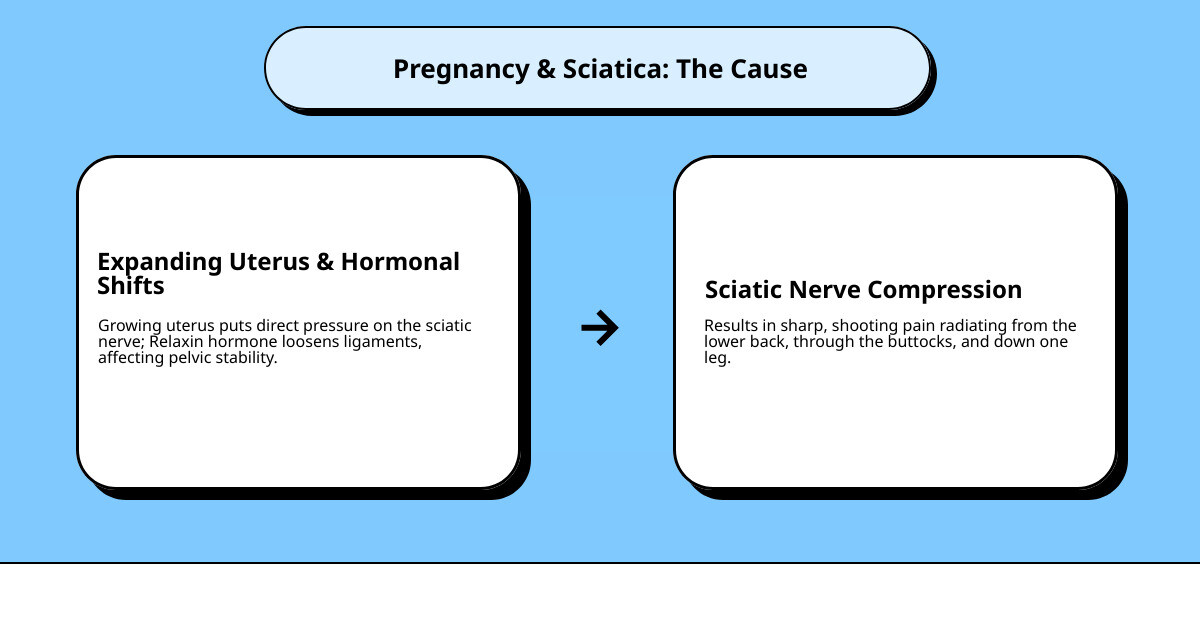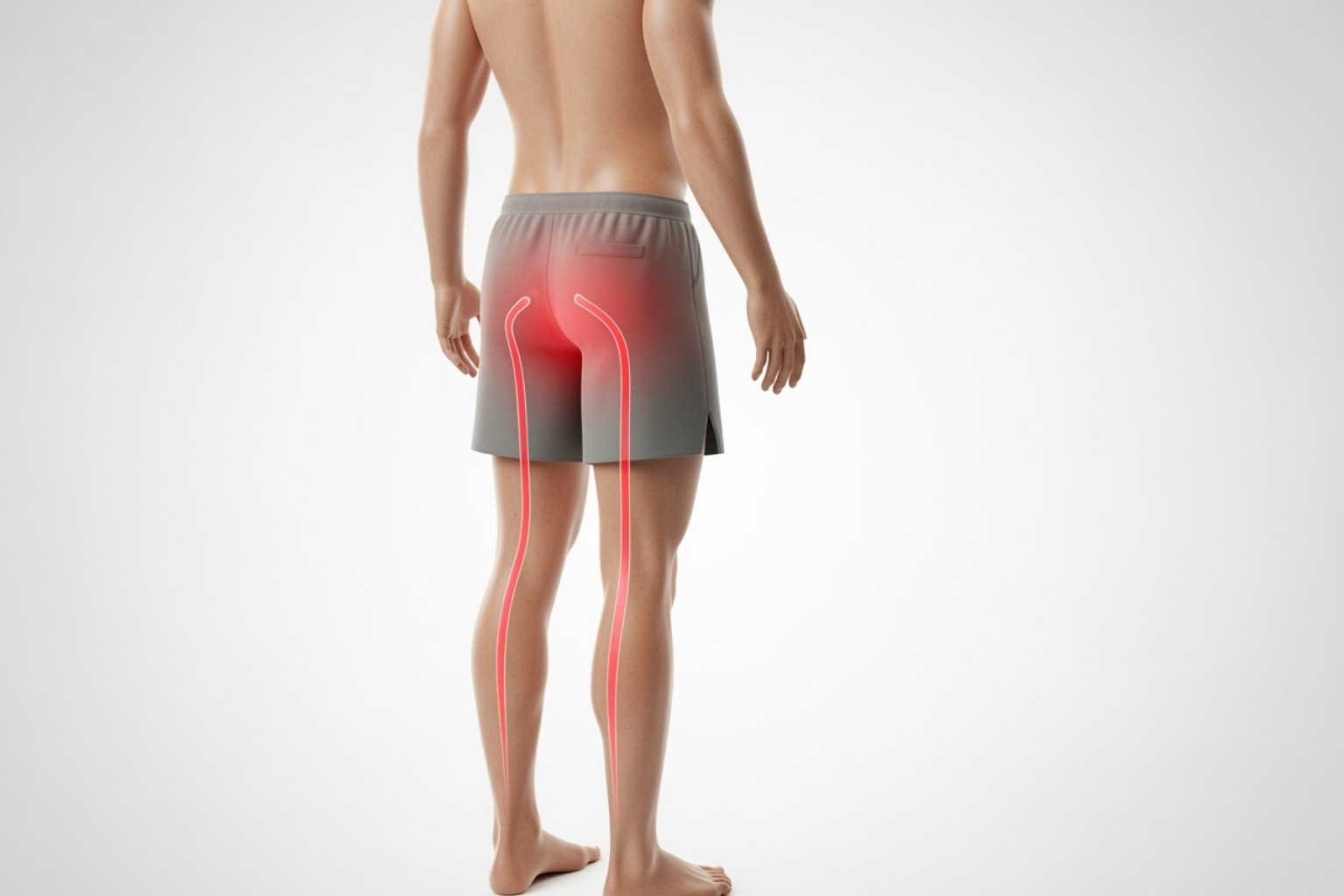Why Pregnancy and Sciatica Nerve Pain Deserves Your Attention
Pregnancy and sciatica nerve pain affects up to 80% of expectant mothers, but it's more than a typical pregnancy ache. Sciatica is a sharp, shooting pain that radiates from your lower back down one leg, often with numbness or tingling. While it can be debilitating, the good news is that it's almost always temporary and resolves after birth.
Quick Relief Guide for Sciatica During Pregnancy:
- Gentle stretches like the seated piriformis stretch
- Posture adjustments like sleeping on your side with pillows
- Heat therapy with warm baths or heating pads (avoiding your belly)
- Low-impact exercise like swimming or walking
- Topical relief with pregnancy-safe creams after consulting your doctor
- Professional support through physical therapy or chiropractic care
This guide will show you safe, effective ways to manage your symptoms. I'm Tony Enrico, and through Neuropasil, I've helped thousands find natural relief from nerve pain, including the unique challenges of pregnancy and sciatica nerve discomfort.

Quick look at pregnancy and sciatica nerve:
Understanding Pregnancy and Sciatica Nerve Pain: Causes and Symptoms
Your sciatic nerve is the longest and thickest nerve in your body, running from your lower back down to your feet. Sciatica isn't a condition itself, but a symptom of this nerve being compressed or irritated. While about 40% of people experience sciatica in their lifetime, pregnancy creates unique conditions that make it especially common. Sciatica is a common complaint for expectant mothers, and understanding why is the first step toward relief. For a deeper dive, see The Definitive Guide to What Causes Sciatic Nerve Pain.
What is Sciatica and How Does it Manifest in Pregnancy?
Sciatica during pregnancy is caused by nerve compression or inflammation. Unlike a general backache, it creates a distinct pain that typically starts in the lower back, travels through one buttock, and radiates down the back of the leg, sometimes to the foot. The sensation can range from a mild ache to intense, debilitating pain. Most women experience it on one side, and it most commonly develops in the third trimester as the body undergoes its most dramatic changes.
Common Symptoms of Pregnancy and Sciatica Nerve Pain
Knowing the specific symptoms of pregnancy and sciatica nerve pain can help you communicate effectively with your doctor.

- Sharp, shooting pain: Often described as an electric shock traveling down the leg.
- Burning sensation: A hot feeling along the nerve's path.
- Numbness and tingling: A "pins and needles" sensation in the leg or foot.
- Muscle weakness: Difficulty lifting the foot (foot drop) or standing on your toes.
- Pain worsens with certain activities: Sitting for long periods, coughing, or sneezing can trigger a jolt of pain.
These symptoms can make daily tasks challenging. Learn more about them in Sciatica Symptoms 101.
Why Does Sciatica Happen During Pregnancy?
The pain of pregnancy and sciatica nerve is caused by a combination of physiological changes:
- Hormonal Changes: The hormone relaxin loosens ligaments to prepare the pelvis for delivery. This can destabilize pelvic joints, leading to nerve pressure.
- Shifting Center of Gravity: As your belly grows, your posture changes to compensate. This forward shift can strain back muscles and pinch the sciatic nerve.
- Uterine Expansion: Your growing uterus can put direct pressure on the sciatic nerve. It can also tighten the piriformis muscle in the buttock, which then compresses the nerve (a condition called piriformis syndrome).
- Fluid Retention: Swelling common in pregnancy can increase pressure on nerves, worsening any existing compression.
Safe and Effective Relief Strategies for Expecting Mothers
When managing pregnancy and sciatica nerve pain, gentle, conservative approaches are best. Always consult your doctor before trying any new remedy. Many safe options can provide relief without medication. For more general tips, see our guide Ease the Ache: A Complete Guide to Sciatica Relief.
Gentle Stretches and Exercises for Sciatica Relief
Movement is key to reducing sciatic pain. Gentle stretches and low-impact exercises improve flexibility, strengthen supporting muscles, and relieve nerve pressure.

- Seated Piriformis Stretch: Sit in a chair and cross one ankle over the opposite knee. Lean forward with a straight back until you feel a stretch in your glute. Hold for 20-30 seconds and switch sides.
- Cat-Cow Stretch: On your hands and knees, inhale as you arch your back (cow) and exhale as you round your spine (cat). This mobilizes the spine and relieves pressure.
- Standing Hamstring Stretch: Place one heel on a low, stable surface. Keeping your back straight, hinge at your hips until you feel a stretch in the back of your thigh. Hold for 20-30 seconds, then switch.
Low-impact exercises like swimming, prenatal yoga, and walking are also highly beneficial. The American College of Obstetricians and Gynecologists offers guidance on safe exercises for pregnancy, but always get your doctor's approval first.
The Importance of Posture and Sleep Positions
Small adjustments to how you sit, stand, and sleep can dramatically reduce pressure on your sciatic nerve.
- Sitting: Keep both feet flat on the floor and use a small pillow for lumbar support. Avoid sitting for more than 30 minutes at a time.
- Standing: Pull your shoulders back and avoid locking your knees. If standing for long periods, rest one foot on a low stool.
- Sleeping: Sleep on your pain-free side. Place a pillow between your knees to align your hips and another under your belly for support. A full-body pregnancy pillow can be a great investment.

At-Home Therapies: Heat, Cold, and Massage
Simple home remedies can be very effective. A warm bath or heating pad (applied to your back, not your belly) can relax tight muscles. For acute pain, a cold pack wrapped in a towel can reduce inflammation. Gentle self-massage with a tennis ball against your glute can also release tension.
For targeted relief, a natural nerve pain relief cream can help. Neuropasil Nerve Pain Relief Cream combines Aloe, Urea, and Menthol for soothing comfort. The cooling Menthol distracts from pain signals and relaxes muscles. As with any product, discuss it with your doctor before use. For more natural ideas, see Finding Freedom: How to Naturally Relieve Sciatica Pain.
Professional and Medical Support
If home remedies aren't enough, professional help is a smart choice. A physical therapist specializing in prenatal care can provide custom exercises and manual therapy. With your doctor's approval, a chiropractor can perform gentle adjustments to realign your pelvis. For severe pain, your doctor might recommend acetaminophen (Tylenol). Crucially, avoid NSAIDs like ibuprofen (Advil) and naproxen (Aleve) during pregnancy, as they can harm your baby. Never take any medication without consulting your doctor.
Management, Prevention, and Postpartum Outlook
Here's the best news: pregnancy and sciatica nerve pain is almost always temporary. For most women, the pain resolves naturally within a few months after giving birth. Knowing this can help you focus on managing symptoms and enjoying your pregnancy. For more on causes and relief, see Why Your Sciatic Nerve Is Screaming: Causes and Relief.
Preventative Measures for Pregnancy and Sciatica Nerve
While not foolproof, these steps can significantly reduce your risk of developing sciatica or lessen its severity:
- Maintain a healthy weight: Follow your provider's guidelines for weight gain to minimize stress on your spine.
- Exercise regularly: Gentle activities like walking, swimming, or prenatal yoga build a strong, supportive core and back.
- Lift properly: Always bend at your knees, not your waist, and keep objects close to your body. Avoid twisting while lifting.
- Wear supportive shoes: Choose low-heeled, comfortable footwear to maintain proper posture.
- Keep moving: Avoid prolonged periods of sitting or standing. Take frequent breaks to walk and stretch.
When to Call Your Doctor
Most sciatica can be managed at home, but certain symptoms require immediate medical attention. Contact your healthcare provider if you experience:
- Severe or constant pain that doesn't improve with self-care.
- Sudden, severe pain after a fall or injury.
- Significant loss of feeling in your leg, foot, or groin area.
- Progressive muscle weakness that affects your ability to walk.
- Loss of bladder or bowel control. This is a medical emergency (Cauda Equina Syndrome) and requires immediate help.
Does Sciatica Affect the Baby or Delivery?
This is a common worry, but rest assured: pregnancy and sciatica nerve pain does not harm your baby. Your little one is safely cushioned and unaware of your discomfort.
Sciatica also typically does not interfere with labor and delivery. Your healthcare team will help you find comfortable positions, and many women find that laboring on hands and knees or using a birthing ball can actually relieve sciatic pressure. The pain usually fades in the weeks and months after birth as your hormones rebalance and the physical pressure is gone.
Frequently Asked Questions about Sciatica in Pregnancy
Here are answers to some common questions about pregnancy and sciatica nerve pain:
How soon does sciatica start in pregnancy?
While sciatica is most common in the third trimester due to the baby's size, it can appear at any stage. Hormonal changes that loosen ligaments begin early in pregnancy, so some women experience nerve irritation in the first or second trimester, especially if they have a history of back issues.
Can I use a pain relief cream for sciatica while pregnant?
Many topical creams are considered safe, but you must consult your doctor first before using any new product. Topical creams are often a good choice because they work locally with minimal absorption into the bloodstream.
Natural ingredients like menthol, aloe, and urea—found in Neuropasil Nerve Pain Relief Cream—are formulated to provide targeted, soothing relief. However, your doctor must approve any product's ingredients for your specific situation. For more on how these creams work, see The Complete Guide to Nerve Pain Relief Creams.
Will the sciatica come back in future pregnancies?
Having sciatica once may make you more susceptible in future pregnancies, as your body may have a "memory" of the postural shifts that cause it. However, it is not inevitable. You can significantly reduce your risk by taking preventative measures between pregnancies. Strengthening your core and back muscles, maintaining a healthy weight, and practicing good posture can build a stronger foundation to support your body during your next pregnancy.
Find Your Path to Pregnancy Pain Relief
Dealing with pregnancy and sciatica nerve pain is a real challenge, but remember: relief is possible, and this condition is almost always temporary. The pain you feel today will likely fade after your baby arrives.
By using the strategies in this guide—gentle stretches, mindful posture, and safe at-home therapies—you can reclaim comfort during this special time. Simple adjustments like using supportive pillows when you sleep and taking short walks can make a significant difference in reducing nerve compression.
For an extra layer of targeted comfort, a natural topical solution can help. Neuropasil Nerve Pain Relief Cream uses Aloe, Urea, and Menthol to deliver fast-acting, soothing relief for nerve and muscle pain. The cooling sensation of Menthol helps ease discomfort and relax tight muscles. As always, consult your healthcare provider before use to ensure it's right for you.
You deserve to enjoy this incredible time. We're here to support you with knowledge and natural solutions. Explore more resources on our Sciatica Pain blog to empower yourself for a more comfortable pregnancy.
References
We've drawn on a range of trusted medical sources and research to bring you the most accurate, up-to-date information about pregnancy and sciatica nerve pain. Understanding the science behind your symptoms empowers you to make informed decisions about your care, and we believe transparency in sourcing is essential. Here are the references that informed this guide:
Cleveland Clinic offers comprehensive medical information on sciatica, helping us understand the fundamentals of this nerve pain condition and its prevalence in the general population. You can explore their resource at Cleveland Clinic - Sciatica. They also provide specific guidance on managing sciatica during the unique journey of pregnancy, which you can find at Cleveland Clinic - How to Handle Sciatica During Your Pregnancy.
The American College of Obstetricians and Gynecologists (ACOG) is a leading authority on women's health, and their guidelines on safe exercise during pregnancy helped us recommend appropriate physical activities for expecting mothers. Their detailed FAQ on exercise can be accessed at ACOG - Exercise During Pregnancy.
For practical stretching techniques and additional insights into managing sciatica pain during pregnancy, we consulted several reputable health platforms. Healthline provided valuable information on pregnancy-safe stretches at Healthline - 7 Stretches for Sciatica Pain During Pregnancy. The Bump offered helpful advice on coping strategies, available at The Bump - How to Cope With Sciatica During Pregnancy. Medical News Today contributed additional perspectives on stretches, massage, and pain relief options at Medical News Today - Sciatica and pregnancy.
UT Southwestern Medical Center provided clinical insights into when sciatica during pregnancy might require medical attention, which informed our guidance on red flag symptoms. Their article can be found at UT Southwestern - Sciatica in pregnancy: When it's more than the usual aches and pains.
We also referenced evidence-based research on interventions for preventing and treating low-back and pelvic pain during pregnancy. The Cochrane Database of Systematic Reviews, a highly respected source of medical evidence, published a comprehensive review by Liddle, S. D., & Pennick, V. (2015) titled Interventions for preventing and treating low-back and pelvic pain during pregnancy, which you can access at Cochrane Library.
Additional valuable information came from WebMD at WebMD - Sciatic Nerve Problems and Pregnancy: What to Do, Penn Medicine Lancaster General Health at Penn Medicine - Sciatic Nerve Pain During Pregnancy, and Chicago Spine at Chicago Spine - Sciatic Nerve Pain During Pregnancy: Everything You Need to Know. Walnut Hill OBGYN offered practical tips at Walnut Hill OBGYN - How to Ease Sciatic Nerve Pain During Pregnancy, and Orthopedic & Laser Spine Surgery provided additional management strategies at Orthopedic & Laser Spine Surgery - 11 Ways to Deal With Sciatic Nerve Pain During Pregnancy.
These resources collectively helped us craft a guide that's both medically sound and practically useful for expecting mothers navigating the challenges of sciatica. We're committed to providing you with information you can trust as you work toward finding relief and enjoying your pregnancy journey.














